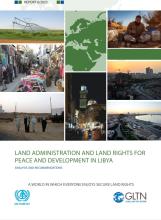Land Library
Welcome to the Land Portal Library. Explore our vast collection of open-access resources (over 74,000) including reports, journal articles, research papers, peer-reviewed publications, legal documents, videos and much more.
/ library resources
Showing items 1 through 9 of 1063.This report is a contribution towards the improvement of land management and land administration in Libya.
To ensure a better and more sustainable future for all, the 2030 Agenda for Sustainable Development (“the 2030 Agenda”) has identified 17 Sustainable Development Goals (SDGs) to be achieved by 2030.
The Global Land Indicators Initiative (GLII) platform was established in 2012 through the joint effort of United Nations Human Settlements Programme (UN-Habitat), the World Bank and Millennium Challenge Corporation with the aim of making global-scale monitoring of land governance a reality by 202
The importance of land manifests in various components of the everyday lives of people insocieties: cultural heritage, livelihood, the environment, economy, and community, among manyothers. Land is a factor of development.
Today, the Coalition for Urban Transitions releases a new report ‘Seizing the Urban Opportunity’, which provides insights from six emerging economies on how national governments can recover from COVID-19, tackle the climate crisis and secure shared prosperity through cities.
UNDP's "Peoples' Climate Vote" reflects over half the world's population after results processed by the University of Oxford. Sixty-four percent of people believe climate change is a global emergency, despite the ongoing COVID-19 pandemic
Nature-based Solutions (NbS) work with nature to benefit both natural ecosystems and the people that depend on them.
Mapping Together helps people use Collect Earth mapathons to monitor tree-based restoration. Collect Earth enables users to create precise data that can show where trees are growing outside the forest across farms, pasture, and urban areas and how the landscape has changed over time.
This paper explores the role of the global food system as the principal driver of accelerating biodiversity loss. It explains how food production is degrading or destroying natural habitats and contributing to species extinction.



